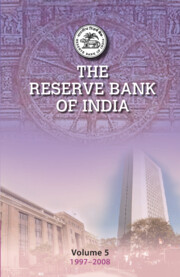Book contents
- Frontmatter
- Contents
- Tables
- Boxes
- Foreword
- Preface
- Acknowledgements
- List of Abbreviations
- 1 Introduction: Managing Liberalisation
- 2 The Macroeconomic Context
- 3 Monetary Management
- 4 Foreign Exchange Market and Management of the Capital Account
- 5 Foreign Exchange Reserves Management
- 6 Financial Markets
- 7 Public Debt Management
- 8 The Payment and Settlement Systems
- 9 Currency Management
- 10 Regulation of the Financial System – Part I: Commercial Banks
- 10 Regulation of the Financial System Part II: Other Financial Institutions
- 11 Supervision of the Financial System
- 12 Rural Credit
- 13 Financial Inclusion
- 14 Communication Policy
- 15 Organisational Change
- Appendices
- Photographs
- Select Bibliography
- Index
7 - Public Debt Management
Published online by Cambridge University Press: 10 January 2023
- Frontmatter
- Contents
- Tables
- Boxes
- Foreword
- Preface
- Acknowledgements
- List of Abbreviations
- 1 Introduction: Managing Liberalisation
- 2 The Macroeconomic Context
- 3 Monetary Management
- 4 Foreign Exchange Market and Management of the Capital Account
- 5 Foreign Exchange Reserves Management
- 6 Financial Markets
- 7 Public Debt Management
- 8 The Payment and Settlement Systems
- 9 Currency Management
- 10 Regulation of the Financial System – Part I: Commercial Banks
- 10 Regulation of the Financial System Part II: Other Financial Institutions
- 11 Supervision of the Financial System
- 12 Rural Credit
- 13 Financial Inclusion
- 14 Communication Policy
- 15 Organisational Change
- Appendices
- Photographs
- Select Bibliography
- Index
Summary
Introduction
The Reserve Bank manages the debt of the central and state governments and acts as a banker to them under the provisions of the Reserve Bank of India (RBI) Act, 1934. While these functions are obligatory in the case of the central government, the Bank undertakes similar functions for state governments by agreement with the governments of the respective states. All states have such agreements.
During the years covered in the book, major institutional reforms were undertaken that redefined the relationship between the Government of India and the Reserve Bank, facilitated market borrowing, introduced new instruments and participants in the government securities market, and contributed to a significant improvement in the state governments’ fiscal and debt management. Many of these changes followed the Fiscal Responsibility and Budget Management Act, 2003 (FRBM Act), and similar legislation passed at the level of the states.
The chapter describes this transition. It covers four main topics, which are the system of public debt management, operation of the system in respect of the central government and state governments during the reference period and miscellaneous issues not covered elsewhere.
The System of Public Debt Management
Objectives
As the manager of public debt, the Bank’s overall objective was to ensure smooth completion of the annual market borrowing programmes (MBPs) of the central and state governments. The Bank tried to pursue debt management in such a manner that the design of the programme was consistent with monetary policy and financial development goals. While performing this role, the Bank tried to achieve three broad aims: minimise cost, mitigate risk and develop the government securities market. During the reference period, cost minimisation was sought to be achieved by proper demand estimation and planned issuance and offering of appropriate debt instruments.
The sovereign debt portfolio is exposed to rollover risk (risk associated with old debt maturing and rolling over into new debt), currency and exchange risks and sudden-stop risks (abrupt cessation of capital flow). Even though raising debt in foreign currency might at times be cost-effective, and provide a wide and varied investor base, such dependence could mean exposure to sharp volatility in the exchange rate. Given these considerations, no sovereign foreign currency bonds were issued by India.
- Type
- Chapter
- Information
- The Reserve Bank of IndiaVolume 5, 1997–2008, pp. 227 - 285Publisher: Cambridge University PressPrint publication year: 2023



